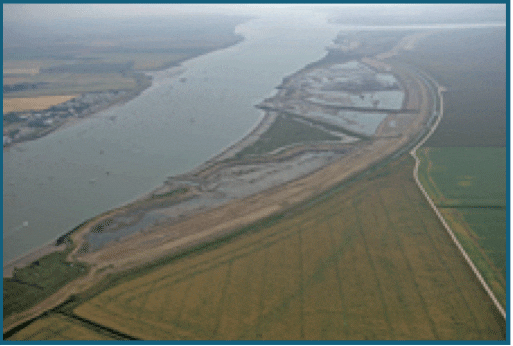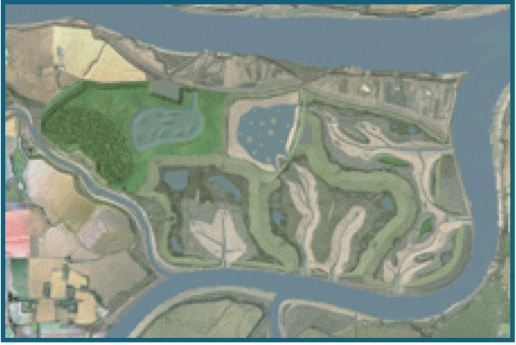Background to managed realignment
In certain coastal and estuarine locations, the best and most sustainable way to enhance flood protection, while simultaneously creating and restoring important coastal habitats, is to realign the sea wall in a landward direction. Over the last 20 years around 50 such realignment projects have been completed in the UK. These projects typically involve building new sea walls at the back of the site and then either breaching the old wall to fully open up the land to tidal waters (called ‘managed realignment’) or constructing tidal exchange structures such as sluices in the old wall to achieve the same result but with greater control of the new tidal lows (called ‘regulated tidal exchange’). More details about completed projects and those in northern Europe can be found in the ‘Online Managed Realignment Guide’ www.abpmer.net/omreg.
These realignment projects have been very successful in achieving their main defence and habitat creation objectives. It has also been shown that marine species can colonise these newly flooded areas and quickly enhance biodiversity. In addition there are a range of other social and economic benefits that arise from these schemes, depending upon their design and location. For instance they can encourage tourists to visit an area; improve water quality and can become very important feeding and nursery grounds for fish species, including commercially important species such as bass and herring.
What has been less well studied though is the potential that they provide for supporting local commercial shell fishing activities. However, the fact that they could do this has been recognised by the Environment Agency who carried out a series of small-scale cockle growth trials at the 115ha Wallasea Island managed realignment site. This realignment site was implemented by Defra in 2006 and lies at the confluence of the Crouch and Roach estuaries. Based on these cockle trials and a further desk-based review study, the Environment Agency (under the EU ‘ComCoast’ project) produced information leaflets on shellfish farming opportunities within their ‘Coastal Farm Business Diversification’ information series. In particular, the potential for managed realignment sites to support cockles, clams and razorfish was identified.

Reason for the shellfish trials
To further investigate the potential relationship between shellfish culture and managed realignment, the Royal Society for the Protection of Birds (RSPB) has been funding more shellfish growth trials on this Wallasea Island site. The first phase of these studies was undertaken between 2009 and 2010 by the River Roach Oyster Company (RROC) with input from ABP Marine Environmental Research (ABPmer). The findings from this work will be used to inform the implementation of the RSPB’s large-scale (677ha) coastal habitat restoration project. This project encompasses much of the rest of Wallasea Island. This RSPB scheme is called the Wallasea Island Wild Coast project and it will restore the island to the condition it was in prior to its being claimed from the sea about 400 years ago. The scheme will convert the island back to a large and complex mosaic of mudflat and saltmarsh and will involve both realignment and regulated tidal exchange techniques to achieve this.
The RSPB worked with ABPmer to design this project and, in doing so, placed particular emphasis on avoiding impacts to shellfish cultivation in either of the adjacent estuaries. This is because the Roach and lower Crouch estuaries are designated as shellfish waters and there are several areas designated as Shellfish Harvesting Areas with a number of commercially exploited beds supporting oyster, mussel and clam species. This present fishery is relatively modest compared to its peak when the Roach beds supported 140 men working 14,000 tubs (with up to 2,000 oysters in each tub). This decline has been attributed to the severe winter on 1962/63 and the effects of TBT. They may well also be related to the ongoing physical changes in the estuaries and the decline in natural marsh habitats that has occurred, and is continuing to occur, largely as a consequence of historical man-made interventions. However, in recent years there has been an increase in both native and Pacific oysters in the estuaries, together with some cockle and mussel fishing.
For both the shellfishing industry (in the Roach and elsewhere) and the RSPB, therefore, there are valuable lessons to be learned here by undertaking further trials and pushing forward our understanding of the relationships between natural and restored habitats and shellfish cultivation. In addition to being important for understanding this interaction with shellfisheries, any work that can inform the oyster fishing industry has a potential ecological benefit in its own right because the native oyster is a Biodiversity Action Plan (BAP) species.

Results of the trials
For these new 2009 to 2010 shellfish trials, the RROC placed three species at five locations within the realignment site. The species were native oyster (Ostrea edulis), mussels (Mytilus edulis) and clam (Tapes decussatus). It had been hoped that cockle (Cerastoderma edule) could also be tested but there was not sufficient seed stock for this species to be included in large numbers (one individual only was present). These were positioned in trestles or on stock bags at five different sites within the channels that drain the site and which have developed from the pre-breach borrow dyke and agricultural field drain complex. These channels were the lowest lying areas of the sites and the ones which are most often inundated by tidal waters. Unfortunately, high mortalities of native flat oysters and the clams were encountered during the test period due to the cold winter weather (especially during November 2009). However, a number of valuable findings still emerged from these investigations.
For instance it was found that the mussels showed slow but steady growth throughout the test period while the one cockle within the clam stock bag grew very well indeed. It was also found that native oysters, rock oysters (Crassostrea gigas) and mussels had colonised the low elevation areas of the site near the breaches both inside and just outside. The naturally ‘self settling’ native oysters were found to survive the cold winter whereas those in the trestles or in the cultivated beds outside in the estuary did not. This finding alone indicates that realignment sites can make a contribution to the preservation of this BAP species.
Bacteriological tests on some of the naturally settled rock oysters showed that they were ‘Class A’ and thus, in theory, they would be suitable for harvesting for human consumption directly from the bed. In many instances the species collected from the commercially worked beds are also Class A although overall these beds are typically designated as Class B and therefore need to undergo a purifying process after collection.
For further details, the RROC report of this work can be downloaded from the ABPmer online managed realignment guide web site that was quoted previously.

